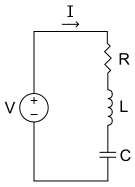Electronics | Foreword | Basic Electronics | Complex Electronics | Electricity | Machines | History of Electronics | Appendix | edit
RLC Series
An RLC series circuit consists of a resistor, inductor, and capacitor connected in series:
By Kirchhoff's voltage law the differential equation for the circuit is:
or
Leading to:
- ±
with
- and
There are three cases to consider, each giving different circuit behavior, .
- .
- =
Equation above has only one real root
- s = -α =
- ,
- >
Equation above has only two real roots
- ±
- .
Equation above has only two complex roots
- + j
- - j
Circuit Analysis
R = 0
If R = 0 then the RLC circuit will reduce to LC series circuit . LC circuit will generate a standing wave when it operates in resonance; At Resonance the conditions rapidly convey in a steady functional method.
R = 0 ZL = ZC
If R = 0 and circuit above operates in resonance then the total impedance of the circuit is Z = R and the current is V / R
At Resonance
- Or
At Frequency
- I = 0 . Capacitor opens circuit . I = 0
- I = 0 Inductor opens circuit . I = 0
Plot the three value of I at three I above we have a graph I - 0 At Resonance frequency the value of current is at its maximum . If the value of current is half then circuit has a stable current does not change with frequency over a Bandwidth of frequencies É1 - É2 . When increase current above circuit has stable current over a Narrow Bandwidth . When decrease current below circuit has stable current over a Wide Bandwidth
Thus the circuit has the capability to select bandwidth that the circuit has a stable current when circuit operates in resonance therefore the circuit can be used as a Resonance Tuned Selected Bandwidth Filter
